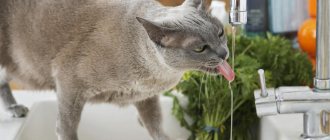The causative agent of the disease
An RNA virus, it is distributed on many continents. The pathogen has average resistance to high temperatures, is destroyed in an hour at 54-60o C, and dies instantly at 100o C. It is not resistant to low temperatures and can be stored frozen for several months, but it dies if repeatedly frozen and thawed.
The virus cannot survive outdoors. It also dies quickly in slightly alkaline or slightly acidic environments, but can survive more than a day in the gastric juice and several hours in the intestines, so sometimes cats become infected by eating rodents that have died from rabies. But rabies is transmitted from a cat to a person only through a bite.
Healing time
Scarring of a cut after a cat scratch depends on many factors. Firstly, these are the individual characteristics of the body. If you have a strong immune system, the wound healing process lasts on average 3-5 days. In older age, natural regeneration slows down, so scratches from a cat can heal in 5-7 days.
Secondly, the correct treatment of the wound. If the scratch was treated in a timely manner and the pathogenic microflora did not have time to enter the general bloodstream, then the healing process will not be interfered with by any third-party factors. Using products with dexpanthenol speeds up the process by 2-3 days, making the scar less noticeable.
Thirdly, the presence or absence of chlamydia infection. If felinosis develops, long-term treatment will be required, and the wound itself may not heal for a long time and become wet.
Fourthly, the depth of the scratch. Superficial cuts heal faster than deep cuts.
On average, the process of epithelial regeneration after a cat scratch is 3-7 days. During this time, a number of changes occur in the wound, from the inflammatory process to the formation of scar tissue. Factors that can aggravate the natural wound healing process include:
- re-infection of the wound with pathogenic microorganisms in water and air;
- improper care of the wound surface;
- pathologically reduced immunity;
- the presence of chronic skin diseases of an infectious-inflammatory nature.
If redness, itching or purulent plaque appears around the wound, it is better to continue treatment under the supervision of a specialist.
Distribution and pathogenesis
The pathogen is transmitted by bites , after which the first sign may be itching in the bite area. The virus multiplies on the cells of the nervous tissue, and it is transmitted through them, gradually rising to the central nervous system (the spine and then the brain). In addition, the pathogen can be spread through the blood or lymph flow, but this is only an additional method.
When a cell is infected, the virus releases neurotoxins, which cause the symptoms characteristic of rabies. The pathogen affects all nerves, not just the central nervous system; in particular, it affects the nerve ganglia of the salivary glands, which causes severe salivation. At the same time, it penetrates the salivary glands themselves.
The incubation period in cats lasts from 3 days to 3 weeks, and in humans from 10 days to 2 months. The virus is detected in saliva 8-10 days before the first symptoms appear.
At the same time, there are cases when the incubation period was reduced to one day for a cat and up to 5 days for a person, or, conversely, extended by several years.
Cat scratches
“I’m an avid cat lady, so it’s no wonder that my hands are constantly covered in scratches. As a rule, they leave red and blue stripes for a long time. How can you get rid of them?” Daria Ivanyushkina, Vladivostok
Tatyana Pavlovna Pyzhevich, an infectious disease specialist at City Clinic No. 81 in Moscow, is consulting.
Cat scratches do take a long and painful time to heal. And, of course, it is best to try not to let games with your favorite dog reach the critical moment when she releases her claws. But if something like this does happen, the main thing is not to let things take their course. Scratches, as well as bites, should be immediately treated with a 2% hydrogen peroxide solution, and then with iodine or alcohol. However, these are traditional remedies, and they are needed in order to prevent infection. And to speed up the healing process and to make unattractive red and blue stripes disappear faster, there are many modern remedies that can be purchased at the pharmacy. Miramistin, a drug based on myristic acid, has proven itself well. Many experts consider it one of the best antiseptics today, which can replace a good half of the home first aid kit. This is an excellent remedy for preventing suppuration of wounds. In addition, it avoids antibiotics that many people dislike, does not cause any allergic reactions, and therefore is suitable for children, who especially often suffer from cat scratches and bites. Ask your pharmacist for a bottle with a green label - any pharmacy probably has it. There is another good drug - the so-called “Emu Fat”. It should be applied to wounds morning and evening. Also, morning and evening, lubricate the scratch areas with colloidal silver. And if you combine these two products, scratch marks will disappear even faster. So, as you can see, you can get rid of the consequences of careless games with pets without much effort. The situation is much more serious if Murka gives you an infection. Here we are already talking about illness. I am sure that many, even avid cat lovers, not only do not have the slightest idea about it, but have not even heard of the name. Meanwhile, the disease has several names. This is benign lymphoreticulosis, and non-bacterial lymphadenitis, and, finally, simply “cat scratch” disease - all this is one and the same. The disease is quite serious and infectious. Its pathogen lives in the body of infected cats. Cats themselves do not get sick, but they infect humans through scratching, biting, and licking. The “cat scratch” disease may go away on its own, but it will cause you a lot of trouble for a month or two, or even more. It's better to take action right away. To those remedies that have already been named, you need to add antibiotics. The most commonly used is erythromycin - 500 mg daily. Doxycycline and gentamicin give good results. It has been noticed that people with weakened immune systems are more susceptible to the disease, so it is a good idea to take medications that strengthen the immune system. The disease is also well treated with prednisone. However, it is best if this or that drug is prescribed to you by an infectious disease doctor. Cat scratch disease can be avoided by taking the necessary preventive measures in a timely manner. Cats should undergo regular veterinary examinations. If you are sick, treat them as seriously as you treat yourself. By the way, experts are now discussing the question: is it possible to immunize muskies and whether it is possible to interrupt the transmission of infection to humans. Preliminary data show that microbes in the blood of cats can “live” safely for several years, but successful treatment is quite possible - with the help of antimicrobial drugs. But vaccinated cats are more sensitive to re-infection. One way or another, the danger of “cat scratch” disease remains in any case. Therefore, even if you have vaccinated your cat, you should not let down your guard.
By the way:
One of the first mentions of the disease that a sweet pussy can give to a person is found in the legend of the Egyptian pharaoh Akhenaten.
When a new favorite appeared among his concubines, the pharaoh’s legal wife, the beautiful Nefertiti, gave the foreigner a kitten from her beloved cat. He turned out to be temperamental and loved to scratch. The beauty fell ill. At first, the scratches on my wrist did not heal for a long time, then the abrasions turned red, swollen and festered. In the end, the pharaoh's favorite left the world of the living. The palace was immersed in sadness, and only the wise Nefertiti, stroking the kitten, smiled. Igor PETROV
Probability of infection
Even after being bitten by a cat infected with rabies, the chance of getting the disease is 30-50%. This is due to the fact that the virus remains on the wound itself for some time and does not penetrate inside; therefore, if a person has disinfected the wound, the likelihood of infection is reduced. In addition, your own immunity also has an impact. In addition, the pet does not always manage to bite through human clothing.
If a person is scratched by a cat, then the chances are almost zero. The virus does not survive in open air, including on skin or claws. But at the same time, you need to understand that the saliva of a sick animal often floods the entire lower jaw, dewlap, and sometimes gets onto the front paws.
Contact of saliva on the front paw with an open wound (from a claw) can cause infection. But in this case, the virus will be weakened by exposure to UV rays, and the contact will last a fraction of a second, so the amount of pathogen that penetrates will be minimal. So, although infection through a scratch is theoretically possible, this never happens in practice.
Features of the course of cat disease in an atypical form of the disease
Among the most common forms of atypical felinosis are the following:
- ophthalmic (most common);
- abdominal;
- pulmonary;
- cerebral and others.
When the pathogen enters the mucous membrane of the eye, the patient experiences symptoms of ulcerative-granulomatous conjunctivitis: severe swelling of the conjunctiva and its hyperemia, single or multiple ulcerations, which are granulomatous growths or inclusions in the form of grains. As a rule, only one eye of the patient is involved in the pathological process. With the ocular variant of felinosis, the patient's visual acuity may significantly decrease. These phenomena are accompanied by persistent lymphadenitis of the parotid and submandibular lymph nodes. When examined by an ophthalmologist, characteristic changes in the structures of the visual organs (retina, fundus and optic nerve) can be detected, the most common of which is the “macular star” symptom.
The neurological variant of the feline disease has the most severe consequences. Clinical manifestations can be very different: from fever and a sharp deterioration in the general somatic condition of the patient to disorientation, confusion and coma.
The first symptoms of neurological manifestations appear 2-3 weeks after the onset of the initial manifestations of lymphadenitis. The patient's general condition suddenly deteriorates sharply. This form of felinosis can cause serious diseases: meningitis, encephalopathy, encephalitis, polyneuritis, radiculitis, etc. It is encouraging that this form of the disease occurs in only 2% of patients.
Some authors note the possibility of developing complications from the liver and spleen in cat scratch disease. In such conditions, the patient's liver or spleen is significantly enlarged, and the organs are subject to undulating fever. The general somatic condition of the patient is disturbed, and symptoms of intoxication of the body may appear.
Cat scratch disease, the symptoms of which are very diverse, is a fairly serious pathology that requires immediate intervention by medical personnel.
Symptoms in cats
Cats suffer from a violent form of rabies. A day before the appearance of a vivid clinical picture, pets change in character , becoming either too sociable or too withdrawn. This period is dangerous because the cat’s saliva already contains the virus, but the symptoms are not obvious.
Then comes the stage of excitement . At the same time, they behave extremely aggressively, attacking humans (and even the owner), dogs, and any other animals. They frantically tear up chairs, sofas, carpets, ground and floors, and gnaw on all objects in sight, including inedible ones. A particular danger to humans is that cats often attack silently, so there is no way to prepare and fight back.
The last stage of the disease is paralysis and death . First, there is an alternation of excitement and depression, gradually the periods of depression stretch out and become more frequent. At the same time, paralysis spreads to the entire body, first it affects the lower jaw and larynx (the cat cannot swallow), then the animal’s legs fail. Death occurs due to paralysis of the respiratory center or heart.
Signs in humans
Rabies occurs in humans, just like in all other animals. First, itching appears in the area of the bite, pain and muscle cramps along the nearest nerves are possible. Usually, 1-3 days before a vivid clinical picture, a person is worried about hidden anxiety, causeless fear or severe melancholy.
Then clear symptoms of rabies develop:
- Hydrophobia is the inability to take a sip of water due to panic fear; the muscles of the pharynx and larynx contract convulsively even at the sound of pouring water.
- Photophobia is fear and pain in the eyes from light, even not too bright. Man hiding in dark rooms
- Acousticophobia is panic and fear from any sounds, sometimes even minor noise causes a strong negative reaction.
Paralysis gradually develops. First they touch the facial muscles, then move to the arms and legs. Finally, the paralysis spreads to the vascular and respiratory nerve centers, resulting in death.
Local clinical manifestations
Cat scratches appear as minor damage to the upper layers of the epidermis, which is accompanied by a small amount of blood. In the absence of proper treatment and pathogenic microorganisms entering the bloodstream, symptoms such as:
- swelling of the wound surface;
- suppuration;
- weeping and lack of wound healing;
- painful sensations.
In case of infection with felinosis, the following clinical picture is noted:
- The incubation period lasts 7-14 days, depending on the maturity of the immune system. It is characterized by the appearance of a purulent papule near the source of damage to the skin. Over time, the papule opens on its own, and the purulent contents pour out. An ulcer forms that tends to ooze.
- The acute form of the disease is accompanied by fever and signs of general intoxication. The constantly increasing concentration of chlamydia affects the functioning of the entire lymphatic system, affecting the lymph nodes, spleen, and liver. The febrile period lasts long enough, after which imaginary relief occurs.
- Latent form - inflamed lymph nodes provoke pain on palpation. A biopsy involves obtaining a purulent-serous biopsy.
Important: Use of antibiotics for purulent wounds
What do cat scratches look like?
Without proper treatment, the disease can accompany a person for years and occur in a latent form, periodically exacerbating.
Prevention
Preventive measures are divided into two groups: among animals and among people.
Prevention of the spread of rabies in animals:
- catching stray animals;
- shooting wild animals near large populated areas;
- annual vaccination of domestic dogs and cats;
- walking dogs on a leash and muzzle, walking cats on a leash.
Preventive measures - vaccination - among people are carried out only for risk groups . This category includes veterinarians, representatives of the animal control service, and dog handlers.











